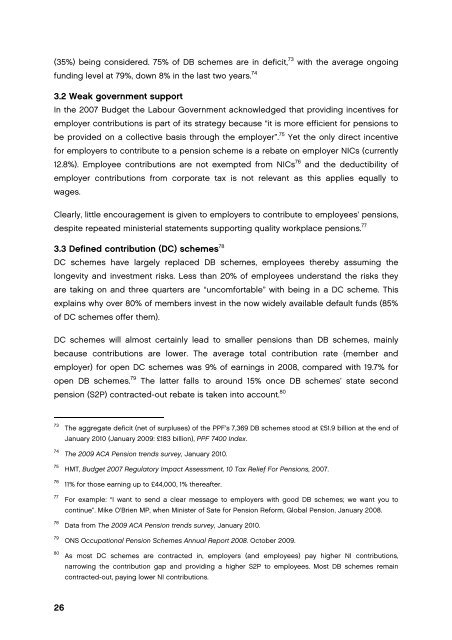Simplification is the key - Centre for Policy Studies
Simplification is the key - Centre for Policy Studies
Simplification is the key - Centre for Policy Studies
Create successful ePaper yourself
Turn your PDF publications into a flip-book with our unique Google optimized e-Paper software.
(35%) being considered. 75% of DB schemes are in deficit, 73 with <strong>the</strong> average ongoing<br />
funding level at 79%, down 8% in <strong>the</strong> last two years. 74<br />
3.2 Weak government support<br />
In <strong>the</strong> 2007 Budget <strong>the</strong> Labour Government acknowledged that providing incentives <strong>for</strong><br />
employer contributions <strong>is</strong> part of its strategy because “it <strong>is</strong> more efficient <strong>for</strong> pensions to<br />
be provided on a collective bas<strong>is</strong> through <strong>the</strong> employer”. 75 Yet <strong>the</strong> only direct incentive<br />
<strong>for</strong> employers to contribute to a pension scheme <strong>is</strong> a rebate on employer NICs (currently<br />
12.8%). Employee contributions are not exempted from NICs 76 and <strong>the</strong> deductibility of<br />
employer contributions from corporate tax <strong>is</strong> not relevant as th<strong>is</strong> applies equally to<br />
wages.<br />
Clearly, little encouragement <strong>is</strong> given to employers to contribute to employees’ pensions,<br />
despite repeated min<strong>is</strong>terial statements supporting quality workplace pensions. 77<br />
3.3 Defined contribution (DC) schemes 78<br />
DC schemes have largely replaced DB schemes, employees <strong>the</strong>reby assuming <strong>the</strong><br />
longevity and investment r<strong>is</strong>ks. Less than 20% of employees understand <strong>the</strong> r<strong>is</strong>ks <strong>the</strong>y<br />
are taking on and three quarters are “uncom<strong>for</strong>table” with being in a DC scheme. Th<strong>is</strong><br />
explains why over 80% of members invest in <strong>the</strong> now widely available default funds (85%<br />
of DC schemes offer <strong>the</strong>m).<br />
DC schemes will almost certainly lead to smaller pensions than DB schemes, mainly<br />
because contributions are lower. The average total contribution rate (member and<br />
employer) <strong>for</strong> open DC schemes was 9% of earnings in 2008, compared with 19.7% <strong>for</strong><br />
open DB schemes. 79 The latter falls to around 15% once DB schemes’ state second<br />
pension (S2P) contracted-out rebate <strong>is</strong> taken into account. 80<br />
73<br />
74<br />
75<br />
76<br />
77<br />
78<br />
79<br />
80<br />
The aggregate deficit (net of surpluses) of <strong>the</strong> PPF’s 7,369 DB schemes stood at £51.9 billion at <strong>the</strong> end of<br />
January 2010 (January 2009: £183 billion), PPF 7400 Index.<br />
The 2009 ACA Pension trends survey, January 2010.<br />
HMT, Budget 2007 Regulatory Impact Assessment, 10 Tax Relief For Pensions, 2007.<br />
11% <strong>for</strong> those earning up to £44,000, 1% <strong>the</strong>reafter.<br />
For example: “I want to send a clear message to employers with good DB schemes; we want you to<br />
continue”. Mike O’Brien MP, when Min<strong>is</strong>ter of Sate <strong>for</strong> Pension Re<strong>for</strong>m, Global Pension, January 2008.<br />
Data from The 2009 ACA Pension trends survey, January 2010.<br />
ONS Occupational Pension Schemes Annual Report 2008. October 2009.<br />
As most DC schemes are contracted in, employers (and employees) pay higher NI contributions,<br />
narrowing <strong>the</strong> contribution gap and providing a higher S2P to employees. Most DB schemes remain<br />
contracted-out, paying lower NI contributions.<br />
26

















